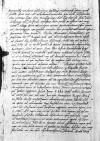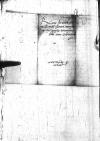List #2774
Marco de la TORRE do Ioannes DANTISCUSCracow (Kraków), 1544-12-06
Regest polski:
Marco de la Torre cieszy się z otrzymanego listu Dantyszka, z dobrych wiadomości o jego zdrowiu, i obiecuje wraz ze współbraćmi modlić się za niego.
Jego własne zdrowie pozostaje bez zmian, dręczą go słabości związane ze starością, przyjmuje je jednak ze spokojem jako drogę ku niebu.
Ubolewa nad powszechną obojętnością i opieszałością w zwalczaniu sekt, przewiduje nadchodzący upadek stanu duchownego.
Władcy Polski, a zwłaszcza królowa [Bona], w żadnym wypadku nie skłaniają się ku sektom. Marco de la Torre ufa, że podobne nastawienie przejmie od rodziców młody król [Zygmunt II August]. Zamierza zachęcić go do tego listownie.
Dziękuje Dantyszkowi za przesłane lekarstwo muszkatołowe (confectiones muscati), które jest jedynym skutecznym środkiem na jego dolegliwości żołądkowe. Prosi Dantyszka o wiadomość, u kogo w Gdańsku można je nabyć. Kiedy bowiem w następnym tygodniu królowa przyjdzie go odwiedzić w jego komnacie (której nie wolno mu opuszczać z powodu chłodów), Marco de la Torre zamierza zasugerować jej zakup tegoż leku dla króla [Zygmunta I]. Lekarstwa nadsyłane królowi z Italii nie są tak skuteczne.
| odebrano Heilsberg (Lidzbark Warmiński), 1544-12-17 Rękopiśmienne podstawy źródłowe:
Pomocnicze podstawy źródłowe:
| ||||||
Tekst + aparat krytyczny + komentarz Zwykły tekst Tekst + komentarz Tekst + aparat krytyczny
Reverendissimo in Christo Patri, Domino, domino
Reverendissime in Christo Pater et Domine, domine fautor et benefactor observandissime.
Post sacrae manus osculum et perpetuam felicitatem.
Supra id, quod vix dici potest, gratissimae mihi Paternitatis Vestrae Reverendissimae fuerunt cf.
Quantum vero attinet meam valetudinem, nihil in me immutatum est, cf. Arist. De gener. 336a.27-28; AURELIANENSIS 2.10 title Utrum idem manens semper idem et similiter se habens natum est facere idem ⌊quia idem manens, idem semper natum est facere idemcf. Arist. De gener. 336a.27-28; AURELIANENSIS 2.10 title Utrum idem manens semper idem et similiter se habens natum est facere idem ⌋. Cum enim semper langueam, de languore ad languorem devenio, et quanto ulterius, tanto deterius ob senectam meam iam prorsus viribus effetam. Quae tamen certe non est mihi gravis nec admodum molesta, cum ipsa sit propinquior gradus ad superos ascendendi, quandoquidem malum cf. S. Gregorii Nysseni in funere Pulcheriae oratio: finis vitae carnalis initium augustioris vitae ⌊hoc, quod vulgo mortem vocant, initium est immortalitatis vitae futuraecf. S. Gregorii Nysseni in funere Pulcheriae oratio: finis vitae carnalis initium augustioris vitae ⌋ , pereuntibus sua lege et tempore corporibus, animis vero in caelestem patriam migrantibus. Verum facessere philosophica haec sinam, ne cf. Adagia 3725 Solem adiuvare facibus ⌊facula solem illustrarecf. Adagia 3725 Solem adiuvare facibus ⌋ velle videar.
De impia autem et perfidorum secta, cum videam omnes quaerere, quae sua sunt et non quae Ihesu Christi, et ea, quae ad animarum salutem pertinerent, negligere, quid aliud afferam, et non quidem sine magno stomacho, nisi quod nunc verificari video
cf. Vulg. Ps (G) 68:24; Vulg. Rm 11:10 ⌊obscurentur oculi eorum, ne videantcf. Vulg. Ps (G) 68:24; Vulg. Rm 11:10 ⌋ etc. Si enim naturali lumine dumtaxat, et non divino, afflati duceremur, clarius adhuc luce meridiana interitum et ultimum excidium ecclesiastici status istis praeludiis et hac nostrorum conniventia exploratum habere deberemus. Sed vereor, ne id nobis accidat, quod Letters, the main figure of the Acts of the ApostlesLetters, the main figure of the Acts of the Apostles AAWO, AB, D.70, f. 233v proventibus et bonis nostris frui possimus, viderint posteri, quid facto opus erit, et adhibeant remedia pro eorum subsistentia, nos interim laetos dies transigamus”. Sed hic dicendi finem faciam, latissimus enim scribendi campus hic mihi se offert, ad cuius metam absque taedio et magna animi perturbatione (cum fontes et scaturigines, ex quibus morbus hic processit, adducendi essent) pervenire non possem.
AAWO, AB, D.70, f. 233v proventibus et bonis nostris frui possimus, viderint posteri, quid facto opus erit, et adhibeant remedia pro eorum subsistentia, nos interim laetos dies transigamus”. Sed hic dicendi finem faciam, latissimus enim scribendi campus hic mihi se offert, ad cuius metam absque taedio et magna animi perturbatione (cum fontes et scaturigines, ex quibus morbus hic processit, adducendi essent) pervenire non possem.
Nostri
Magnas gratias habeo Vestrae Reverendissimae Paternitati tamquam domino meo colendissimo, quod dignata fuerit mihi mittere confectiones muscati, quae certe gratiores longe apud me exstiterunt, quam si mihi tantumdem auri transmisisset. Quo licet non abundem, tamen non ita egeo, sicut hac confortatione stomachi, qui quando deicitur, hoc uno tamquam praesentaneo remedio resumit vires et refocillatur. Utinam scirem, quomodo et apud quem
Quod reliquum est, Paternitati Vestrae Reverendissimae omnem felicitatem cupio. Quam rogo, ne eius solito amore et gratia me prosequi desistat. Ego semper profitebor me sui nominis observantissimum futurum.
Quam Dominus  AAWO, AB, D.70, f. 234r Deus sua in paper damaged⌈[n]n paper damaged⌉finita bonitate quam diutissime conservare dignetur.
AAWO, AB, D.70, f. 234r Deus sua in paper damaged⌈[n]n paper damaged⌉finita bonitate quam diutissime conservare dignetur.
Dat(ae) or Dat(um)⌈Dat(ae)Dat(ae) or Dat(um)⌉
Eiusdem Paternitatis Vestrae Reverendissimae obsequentissimus frater



